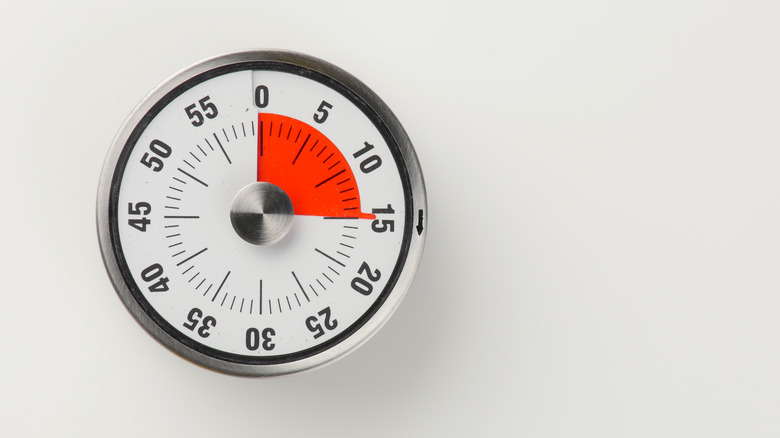Is It Healthy To Set Time Aside To Worry?
Worrying throughout the day can drain your energy and take away your focus on more important things. It can be challenging to move on with your day when you dwell on the thoughts that consume your mind. For example, you might have a sick family member, and you're worried about their health while you're at work, and it distracts you from getting your job done that day. Or, you're feeling overwhelmed and anxious with the number of tasks you have to get through throughout the day that instead of tackling one at a time, you worry about not getting them done.
When we worry for a long time, it can create some serious health issues. Even though it's normal to worry about things, worrying too much can lead to chronic stress, claims The Baton Rouge Clinic. Chronic stress can release too much cortisol, a stress hormone that can cause heart disease, digestive problems, and a poor immune system. A few natural things you might worry about are job interviews, a first date, or a solo trip, but those feelings go away as soon as they start, and you realize everything is alright. It's crucial to remember that you're in control of your thoughts to help calm your mind.
However, there are a few times when we allow our minds to be in control of us. When we let our thoughts win, we have to regain control. Here's how you can worry in a healthy way.
Set aside 15 to 30 minutes to worry
While it may sound odd, setting aside time to worry helps improve your focus and clarity throughout your day. Instead of dwelling on things or thoughts that concern you, put them at the back of your mind and schedule time to think about them. The worry time technique benefits folks who get consumed by their thoughts and can't find their way to move on. For example, if you tend to feel anxious at work and worry about particular things happening, writing them down and reviewing them later can allow you to come up with future solutions if they happen again.
Creating the habit of jotting down things that make you anxious and revising them later in the day can take time. To follow the technique, you'll want to set a time of 15 to 30 minutes where you talk to yourself about the things that made you worried. It's essential to schedule it at the same time every day to stay consistent and create a new routine. However, you don't want to go over 30 minutes of worry time to prevent overthinking.
Schedule your worry time at the same time
Creating healthy habits means doing them around the same time every day, so you don't get off track. When thinking about what time you should schedule your worry time, try to do it when you have time to yourself in the evening. You want to give yourself the entire day for anything to happen so you can reflect on your worries all at once. If you set your worry time at 1 pm and you worry again at 3 pm, you'll have to schedule a second worry time, which can be draining. So, try picking a time between 5 pm to 7 pm. It's early enough before bedtime that you can take time to think without letting your worries keep you up at night.
In addition, scheduling your worry time is just as important as finding the perfect spot to think. Your worry time is an act of self-care, so you want to be somewhere that's calming and you won't get interrupted. Some people find that sitting in their car brings them peace in a quiet, enclosed space. On the other hand, other people might feel that their bathroom or bedroom is where they can get some alone time. Anywhere you decide to be, make your worry time your sacred time.
Plan an activity when the timer goes off
Once your timer goes off, it can be challenging to pull yourself away from thinking about what worried you, which is why you should plan an activity that can give you something to look forward to. Plus, it will force you to stop thinking about any thoughts you're pondering once the time is up. Your after-worry time activity doesn't have to take up a couple of hours. It can be as little as 10 minutes. For example, do a face mask, read your favorite magazine, go for a short walk, or make some tea. On the other hand, if you prefer to do an hour-long activity, you can cook a meal, clean your space, or read a new novel.
Looking forward to your activity allows you to easily transition into a positive mindset, especially if some days are more complex. Remember not to be too hard on yourself when reflecting during your worry time. Things that are sometimes out of our control happen, but if we think about them and decide what to do differently, we'll know what to do the next time we start to worry over the same thing.
Try talking to someone about what worries you
Setting aside time to reflect on the things that worried you can sometimes be overwhelming, even if you put them aside until the end of the day. However, talking to someone close to you can help relieve some of your worries and stresses, even if they're just listening. On the other hand, if you're seeking advice from someone, you can ask a friend or family member for guidance to help work or understand your worries and anxiety. In addition, opening up to others can offer a fresh perspective rather than sticking to the same one.
If you feel that your worry time and talking to a close friend isn't helping as much as you hoped, there are always mental health professionals you can talk to. They'll know the best route to take to get your worries under control. In addition, you'll be able to follow any exercises they recommend to help you control your thoughts and have a clearer mindset.




